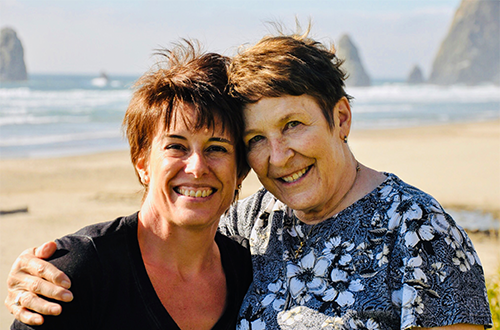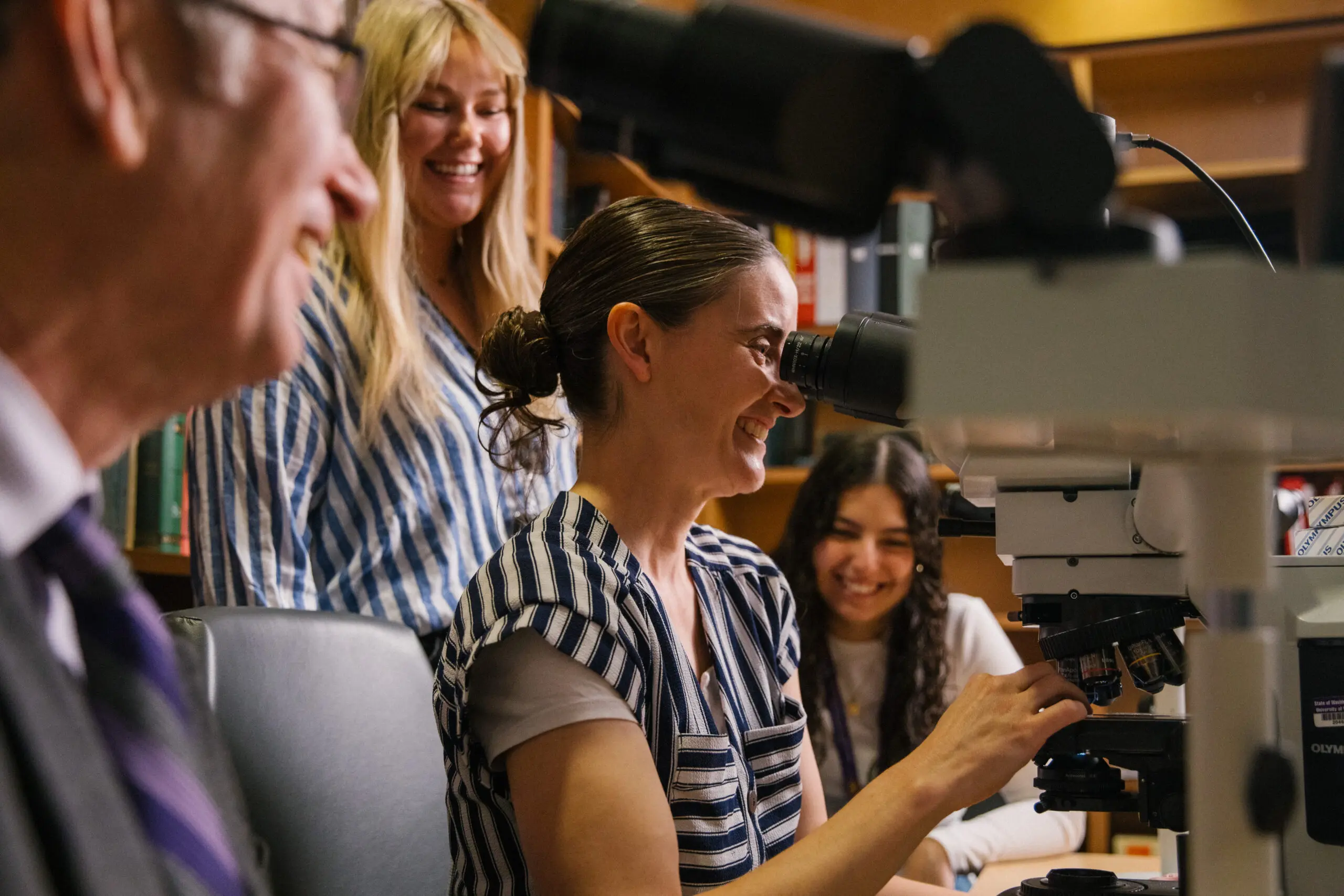Beverley ‘Bev’ Heins and her daughter Lisa Koch were always best friends. As the youngest of four and the only girl among her siblings, Lisa has fond memories of her childhood in Billings, Montana, and says she and her mom would “chum up” and go for walks in the woods whenever her brothers and father were off fishing.
“We loved to laugh,” says Lisa. “She was a kid at heart.”
The family led an active lifestyle, with plenty of time spent water skiing, camping and golfing. Bev loved children and her job as a secretary in the same school district where Lisa’s father taught art. Lisa’s parents bought a little place about 60 miles outside Billings on the Stillwater River, which became Bev’s sanctuary spot — an oasis in nature.

Beverley ‘Bev’ Heins (R) and her daughter Lisa Koch (L) were always best friends.
As an adult, Lisa stayed close to home, earning her bachelor’s degree from Montana State University and then getting a job at UPS in Billings, where she met her future husband, Jim. They were married in 1985.
Jim appreciated being welcomed into this tight-knit family, especially since he had grown up as an only child. “Lisa’s parents were always active and happy,” he says. “They gave me hope in getting older.”
Jim’s employer needed him to work in Seattle, so eventually they moved to the area. There were still plenty of visits back and forth to maintain close family ties.
Around 1996, Bev started having pain in her left foot and was diagnosed with a neuroma (a non-cancerous tumor that grows on nerve tissue). It was surgically removed. But the pain didn’t stop, and for years, her doctors couldn’t diagnose what was wrong. She tried medications, herbal supplements, yoga, acupuncture, meditation and deep breathing. She went to physical therapy and even learned tai chi, but the pain was so severe she was only getting about four hours of sleep at night.
Eventually, her podiatrist referred her to John C. Oakley, MD ’72, director of the Northern Rockies Regional Pain Center. Oakley completed his residency in neurosurgery at UW Medicine and became interested in pain medicine. He diagnosed Bev with reflex sympathetic dystrophy (RSD), now known as complex regional pain syndrome (CRPS).
The mystery of chronic pain
Pain is supposed to have a purpose. It warns us when something is wrong and then fades as we heal. But for people with complex regional pain syndrome, that relief never comes. Instead, their pain lingers — sometimes growing worse over time.
“It often follows a trauma to an extremity, like an arm, leg, foot or hand,” says Brett Stacey, MD, medical director at the Center for Pain Relief at UW Medical Center – Roosevelt. “The extremity doesn’t just hurt where the trauma was, but in a broader area. It’s sensitive to things that you shouldn’t be sensitive to. Taking a shower or a cat’s tail brushing against your leg can be painful.”
There is no one-size-fits-all approach to treatment because each patient — and how their pain impacts them — is unique. Chronic pain is the number one reason people see a doctor and is a leading cause of disability in the U.S. By the time a patient reaches a pain specialist, they’ve typically seen several providers who haven’t been able to find what works.
This is one reason why UW Medicine was the first institution to take a multidisciplinary approach with the creation of its pain clinic in 1961, thanks to the late John Bonica, MD, professor and chair of the UW Department of Anesthesiology. His book, “Bonica’s Management of Pain,” published 72 years ago, is still in print and used widely today, with a new chapter on CRPS written by Stacey, Yian Chen, MD, and Kaitlin Touza, PhD, to be added later this year.
And the pain clinic has since grown into the UW Medicine Division of Pain Medicine, which provides full-spectrum care, develops innovative therapies, and trains the next generation of healthcare leaders specializing in pain. The division also began UW TelePain to increase knowledge and confidence in chronic pain management among practitioners.
It’s the kind of care that’s lacking in many rural areas, where providers may not have been trained in pain therapies and instead default to opioid medications, or patients face long driving distances to larger healthcare systems that can offer specialized care.
These are just some of the factors that contributed to the devastating nationwide opioid epidemic. The Division of Pain Medicine and UW faculty recognized the danger and became an early advocate for better guidelines and restricting dosage levels. As a result, the state of Washington passed the first bill in the country in 2010 requiring health boards and commissions to adopt more stringent rules regarding opioids for pain management.
Something that might have helped Bev when her own condition began to worsen years prior.
A silent struggle
Oakley gave Bev hope and, in 2001, implanted a spinal cord stimulator to try to break the pain signals. It cut her pain in half. Another doctor prescribed her OxyContin and oxycodone for breakthrough pain (sudden, severe flare-ups). This was the beginning of her drug dependence.
Sadly, Oakley passed away a few years later, leaving her with less experienced providers. Her pain began to worsen, and eventually, an infusion pump was implanted to give her a steady drip of Dilaudid (an opioid medication) because the stimulator wasn’t enough.
“Mom wouldn’t say a lot about her pain — she never complained and was the strong, silent type,” says Lisa. “Her primary care doctor did his best, but this was an area he just didn’t have knowledge in. This led her to other specialists who didn’t treat her whole self.”
Bev’s weekly one-hour calls with Lisa turned into 15-minute calls due to fatigue and brain fog. Family members noticed that she’d withdraw during gatherings to rest instead of chatting at the kitchen table or sitting around the campfire.
But that’s not to say Bev gave up.
“She was determined to stay on her feet and not let the disease beat her,” says Lisa. “She walked a mile every day until they had to move to an assisted living facility.”
Around the same time, Bev was diagnosed with stage 2 breast cancer, which seemed to respond well to treatment. But the CRPS continued to limit her family participation. A couple of days before her granddaughter’s wedding reception, she told Lisa that she was having horrific nightmares and didn’t feel well. It turned out her infusion pump had run out, and she was experiencing opioid withdrawal symptoms. She had to be hospitalized for four days and missed the family celebration.
“That had the biggest impact on our family, but she was always there for us, positive and full of love and laughter,” says Lisa.
Bev’s pain increased dramatically in 2022. Lisa and Jim were connected to Stacey and were hoping to find a way to get Bev help through the pain clinic when she was diagnosed with a recurrence of breast cancer. She’d assumed the pain she was experiencing was just the CRPS and didn’t seek treatment until it was too far along. Bev died in November 2022 as a result.
Honoring her mother’s legacy by helping others
Lisa and Jim wanted to find a way to honor Bev and help people like her who were struggling with pain, especially in rural areas where patients might not get multidisciplinary or specialized pain care.
Two of their friends are donors and co-chairs of a UW Medicine Men’s Health Council, so they began to explore giving to the pain division and became excited about the possibilities after connecting with Stacey.
“Philanthropy is particularly important for pain medicine because it receives so little research funding, even though pain impacts almost every area of health,” says Stacey. “Having funds available to develop projects makes the division more competitive in attracting top talent. And that helps us do new and different things that can innovate treatment for our region and beyond.”
Thanks to the generosity of Lisa and Jim, the division is working to gather more data from patients with CRPS that could lead to better, more targeted treatments, develop a support group program for patients and their families and expand telehealth to rural areas.
“Philanthropy can be a powerful lever for obtaining this type of funding by allowing us to gather pilot data and perform initial research, which is later used to apply for a larger project,” says Jacob Gross, MD, MPH. Gross is the director of UW TelePain, and his team recently received confirmation of a federal grant to increase outreach and fund the education of providers caring for vulnerable patient populations with chronic pain, including those who are geographically isolated — starting in Montana.
The hope is that one day people like Bev will have better options — and support — to manage their chronic pain.
“My mom was a beautiful woman who deserved to have more focused, coordinated care while she suffered from this mysterious disease,” says Lisa. “I’m hoping that with our assistance, the UW Pain Clinic can help ensure patients know they have someone who understands and is ready to help them find ways to live the best life they can.”
Written by Nicole Beattie


